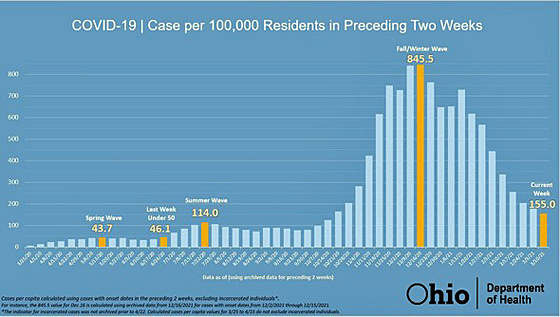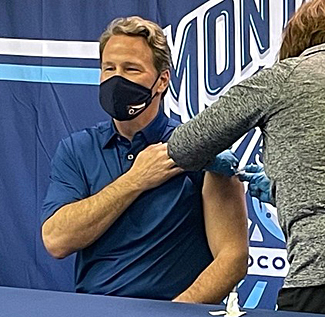Governor discusses nursing home visits
VW independent/submitted information
COLUMBUS — Ohio Governor Mike DeWine and Lt. Governor Jon Husted provided the following updates Thursday on Ohio’s response to the COVID-19 pandemic.

Nursing home visitation
Governor DeWine discussed the new federal regulations for nursing home visitation, as well as Ohio’s Vaccine Maintenance Program. The visitation guidelines, issued by the Centers for Medicare and Medicaid Services (CMS) indicate visitation should be happening in nursing homes. There are a few specific exceptions that would limit visitation, such as outbreaks in the facility or an extreme number of cases in the community. Full information on the federal nursing home visitation guidance is available at cms.gov.
Additionally, Governor DeWine highlighted the progress being made by Ohio’s Vaccine Maintenance Program for nursing homes and assisted living facilities. Ohio’s Vaccine Maintenance Program ensures new nursing home residents and employees, and established residents and employees who previously decided not to receive a vaccine, can still choose to receive one. Governor DeWine emphasized the importance of every nursing home resident receiving a vaccine.
Long-term care facility visitation status is available on the dashboard at coronavirus.ohio.gov.
Statewide case rate
Governor DeWine announced that, statewide, Ohio is currently at a rate of 155 cases of COVID-19 per 100,000 people during the past two weeks. Last week, statewide data put Ohio at 180 cases per 100,000 people.
“In Ohio, we are still at a very elevated level of cases, but today’s health data is certainly trending in the right direction,” said Governor DeWine.
In an evening address last week, Governor DeWine announced that when Ohio reached 50 cases per 100,000 people for two weeks, all health orders will be lifted.
The Ohio Department of Health will update this data each Thursday.
Rapid testing
Governor DeWine also detailed four initiatives that are making rapid COVID-19 tests more accessible to Ohioans:
- Federal Qualified Health Centers
- The state’s ongoing partnership with federally qualified health centers has led to the availability of over 150,000 rapid tests at community health centers. These centers have professionals on-hand to administer the tests free of charge.
- Local Health Departments
- Local health departments have partnered with their communities to make at-home testing available to schools, nonprofit organizations, and first responders.
- Public Libraries
- The state has recently partnered with public libraries to make at-home tests available to more Ohio communities. During the first two weeks, Ohio has partnering with 120 libraries.
- K-12 Schools
- A new partnership launched today will bring 200,000 at-home tests to Educational Service Centers. To increase confidence and safety in schools, Governor DeWine encourages school districts to take advantage of this resource and develop aggressive testing plans.
Between libraries and local health departments, at-home testing is accessible in 76 of Ohio’s 88 counties. Some of these areas had disproportionate access to testing earlier in the COVID-19 pandemic.
Guidance on fairs
Governor DeWine announced that the Ohio Department of Health issued a revised order that allows for the reopening of all fair activities if certain health conditions are met. The updated order includes compliance with the statewide mask order and social distancing. Additionally, there will be a 25 percent maximum for indoor grandstand capacity and a 30 percent maximum for outdoor grandstand capacity.
Additionally, the Ohio Department of Health will issue updated order and guidance regarding festivals, parades, proms, and spring sports. For spring sports, students will not be required to quarantine because they have an incidental exposure to COVID-19 in a classroom unless symptoms develop.
These orders and guidance will be forthcoming from the Ohio Department of Health.

Husted receives COVID-19 vaccine
Lt. Governor Husted on Thursday traveled to his hometown of Montpelier to visit a vaccination site at the Montpelier Superior School, where 840 people were scheduled to receive their first doses of the COVID-19 vaccine.
During the press conference, Lt. Governor Husted joined Montpelier Mayor Steve Yagelski and local resident Shirley Fry in receiving the vaccine, which was administered by Public Health Nurse Tammy Riegsecker. The Lt. Governor became eligible for the vaccine on Thursday, as part of Phase 2B in the state’s vaccination plan in which Ohioans age 50 and above are eligible for vaccination.
Letter addressing PUA fraud
Governor DeWine and Lt. Governor on Thursday sent a letter to President Joe Biden urging the development of a national, coordinated response to ongoing, widespread fraud attempts being committed through the unemployment system, specifically the federal Pandemic Unemployment Assistance (PUA) Program.
See below for an excerpt from the letter:
“We urge you to immediately develop a national, coordinated response to this ongoing attempt to defraud the American people and our national and state governments. While states are doing everything they can to administer the federal programs while maintaining system integrity, a state-by-stare response is proving inadequate. This is not an Ohio problem — it’s a national problem that requires a national solution.”
Current case data
In total, there are 984,934 confirmed and probable cases of COVID-19 reported in Ohio and 17,825 COVID-19 deaths. A total of 51,323 people has been hospitalized throughout the pandemic, including 7,255 admissions to intensive care units. In-depth data can be accessed by visiting coronavirus.ohio.gov.
For more information on Ohio’s response to COVID-19, visit coronavirus.ohio.gov or call 1-833-4-ASK-ODH.
POSTED: 03/12/21 at 12:09 am. FILED UNDER: News







